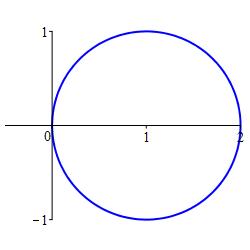15. Polar Coordinates
a. Polar Coordinate System
3. Polar Equations
A rectangular equation is an equation which involves the rectangular coordinates, \(x\) and \(y\). For example, \(y=x^2\) and \((x^2+y^2)^2=2xy\) are rectangular equations.
A polar equation is an equation which involves the polar coordinates, \(r\) and \(\theta\). For example, \(r=e^\theta\) and \(r^2=1+r\sin2\theta\) are polar equations.
On this page, we discuss converting rectangular equations into polar equations and vice versa.
Rectangular to Polar
To convert a rectangular equation into a polar equation, simply substitute \(x=r\cos\theta\) and \(y=r\sin\theta\) and simplify. As a shortcut, you may use the identity \(x^2+y^2=r^2\). You may also cancel factors of \(r\) provided the origin remains a solution.
Convert the rectangular equation \((x^2+y^2)^2=2xy\) to polar form.
Substitute \(x=r\cos\theta\) and \(y=r\sin\theta\) and simplify: \[\begin{aligned} (x^2+y^2)^2&=2xy \\ (r^2)^2&=2(r\cos\theta)(r\sin\theta) \\ r^4&=2r^2\sin\theta\cos\theta \\ r^2&=2\sin\theta\cos\theta \end{aligned}\] We can cancel the \(r^2\) because \((r,\theta)=(0,0)\) is still a solution. Finally, we optionally use the identity \(\sin(2\theta)=2\sin\theta\cos\theta\) to conclude: \[ r^2=\sin(2\theta) \]
Obtain a polar equation for the hyperbola, \(x^2-y^2=1\).
\(r^2\cos2\theta=1\)
or \(r^2=\sec2\theta\)
or \(r=\pm\sqrt{\sec2\theta }\)
\[\begin{aligned} x^2-y^2&=1 \\ (r\cos\theta)^2-(r\sin\theta)^2&=1 \\ r^2(\cos^2\theta-\sin^2\theta)&=1 \\ r^2\cos(2\theta)&=1 \end{aligned}\] We have used the identity \(\cos(2\theta)=\cos^2\theta-\sin^2\theta\). We can also rewrite the equation as \(r^2=\sec(2\theta)\) or \(r=\pm\sqrt{\sec(2\theta)}\).
Polar to Rectangular
To convert a polar equation into a rectangular equation, substitute \(\cos\theta=\dfrac{x}{r}\) and \(\sin\theta=\dfrac{y}{r}\) or if useful \(\tan\theta=\dfrac{y}{x}\). Then substitute \(r^2=x^2+y^2\).
Convert the polar equation \(r^2=\cos 2\theta\) to rectangular form.
We first use the identity \(\cos(2\theta)=\cos^2\theta-\sin^2\theta\) to express everything in terms of \(\sin\theta\) and \(\cos\theta\): \[\begin{aligned} r^2&=\cos2\theta \\ r^2&=\cos^2\theta-\sin^2\theta \\ r^2&=\left(\dfrac{x}{r}\right)^2-\left(\dfrac{y}{r}\right)^2 \end{aligned}\] We now clear the denominator and substitute for \(r^2\): \[\begin{aligned} r^4&=x^2-y^2 \\ (x^2+y^2)^2&=x^2-y^2 \end{aligned}\]
Obtain a Cartesian equation for the polar equation, \(r=2\cos\theta\). Identify the graph by looking at the rectangular equation.
To identfy the graph, first complete the square.
\(x^2+y^2=2x\)
or \((x-1)^2+y^2=1\)
Circle of radius \(1\) centered at \((1,0)\).

\[\begin{aligned} r&=2\cos\theta \\ r&=2\dfrac{x}{r} \\ r^2&=2x \\ x^2+y^2&=2x \end{aligned}\]
To identify the graph, we first complete the square by adding \(-2x+1\) to both sides: \[\begin{aligned} x^2-2x+1+y^2&=1 \\ (x-1)^2+y^2&=1 \end{aligned}\] This is a circle of radius \(1\) centered at \((1,0)\).

Heading
Placeholder text: Lorem ipsum Lorem ipsum Lorem ipsum Lorem ipsum Lorem ipsum Lorem ipsum Lorem ipsum Lorem ipsum Lorem ipsum Lorem ipsum Lorem ipsum Lorem ipsum Lorem ipsum Lorem ipsum Lorem ipsum Lorem ipsum Lorem ipsum Lorem ipsum Lorem ipsum Lorem ipsum Lorem ipsum Lorem ipsum Lorem ipsum Lorem ipsum Lorem ipsum